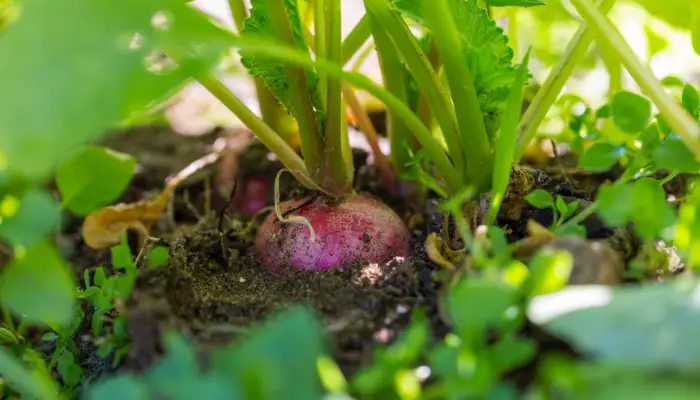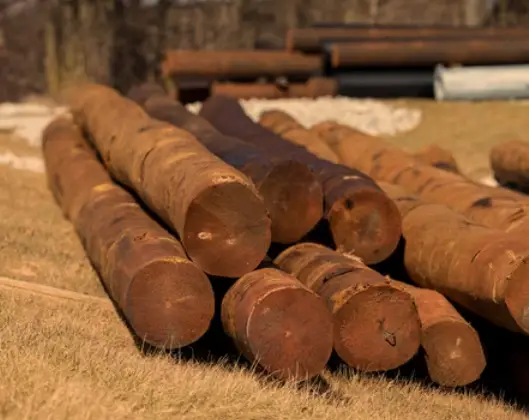How to Grow Radishes from Seeds: A Beginner’s Guide
Growing radishes from seeds is a no-brainer because they are one of the easiest and fastest-growing vegetables you can grow in your garden. They are crunchy, spicy, and nutritious, and they come in a variety of shapes, colors, and sizes. Whether you want to grow them for salads, soups, or snacks, radishes are a great choice for beginner gardeners. In this blog post, we will show you how to grow radishes from seeds and answer some common questions about radish germination.
What is radical germination?
Radish germination is the process by which a radish plant grows from a seed. The radish is a root vegetable that belongs to the mustard family, along with cabbage, broccoli, and kale. Radishes are usually white or red, but they can also be purple, pink, yellow, or black. They have a slightly spicy flavor that varies depending on the variety and growing conditions.
Radishes are a cool-weather crop, which means they prefer temperatures between 50 and 65 degrees Fahrenheit (10 and 18 degrees Celsius). They can be planted in the spring or fall, and they mature quickly, usually in 4 to 6 weeks. Radishes are also frost-tolerant, so they can survive light frosts and even snow.
How to Plant Radish Seeds
To plant radish seeds, you will need the following materials:
- Radish seeds of your choice. You can find them online, in garden centers, or in seed catalogs. Some popular varieties are Cherry Belle, French Breakfast, Daikon, and Watermelon.
- A sunny spot in your garden with well-drained, loose, and fertile soil. You can also grow radishes in containers, raised beds, or window boxes, as long as they have enough space and drainage.
- A garden trowel, a rake, and a watering can.
Here are the steps to plant radish seeds:
- Prepare the soil by removing any weeds, rocks, or debris. You can also add some compost or organic fertilizer to enrich the soil and improve its texture.
- Make shallow furrows in the soil, about half an inch deep and 12 inches apart. You can use your finger, a stick, or a trowel to make the furrows.
- Sow the radish seeds thinly along the furrows, about one inch apart. You can also mix the seeds with some sand to make them easier to spread evenly.
- Cover the seeds lightly with soil, and gently pat the soil down. You don’t want to bury the seeds too deep, or they won’t germinate.
- Water the seeds well, but not too much. You want to keep the soil moist but not soggy. You can use a watering can with a fine nozzle or a hose with a gentle spray.
- Label the rows with the name and date of the radish variety you planted. This will help you keep track of the germination and harvest times.
How Long Does It Take for Radish Seeds to Germinate?
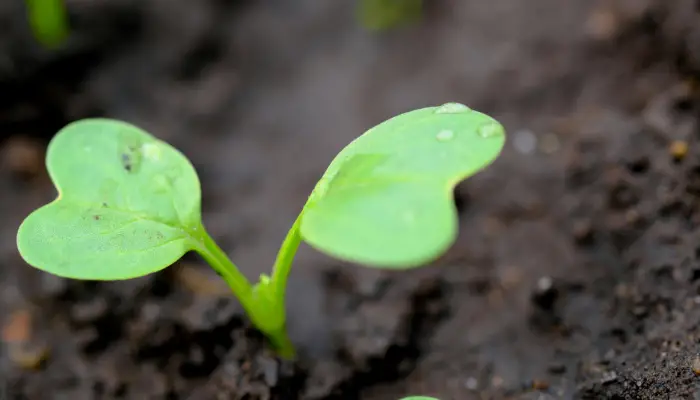
Generally, radish seeds will germinate within a week of planting, as long as the soil temperature is not too cold or too hot. Radish seeds will usually germinate within 10 days, and sometimes as quickly as 3 days, as long as the soil temperature and moisture are optimal.
Some of the factors that affect how long radish seeds take to germinate are:
- Soil temperature: The ideal temperature for radish seed germination is between 65 and 85 degrees Fahrenheit (18 and 24 degrees Celsius). If the soil is too cold, below 40 degrees Fahrenheit (4.4 degrees Celsius), the seeds will germinate slowly or not at all. If the soil is too hot, above 95 degrees Fahrenheit (35 degrees Celsius), the seeds will also germinate poorly or die.
- Soil moisture: The soil should be kept moist, but not wet, during the germination process. If the soil is too dry, the seeds will not germinate. If the soil is too wet, the seeds will rot or get moldy.
- Soil oxygen: The soil should be loose and airy to allow oxygen to reach the seeds. If the soil is compacted or waterlogged, the seeds will suffocate and fail to germinate.
- Seed viability: The seeds should be fresh and healthy to ensure a high germination rate. Old or damaged seeds may not germinate at all or produce weak plants. You can test the viability of your seeds by placing a few of them in a glass of water. If they sink, they are viable. If they float, they are not.
- Seed depth: The seeds should be planted at the right depth, which is about half an inch for radishes. If the seeds are planted too deep, they will have a hard time breaking through the soil. If the seeds are planted too shallow, they will dry out or get eaten by birds or insects.
- Soil pH: The soil should have a neutral or slightly acidic pH, between 6.0 and 7.0, for radish seed germination. If the soil is too alkaline or too acidic, it will affect the availability of nutrients and the growth of the plants.
- Soil salinity: The soil should have a low salt content, as radishes are sensitive to salt stress. High salinity can reduce the germination rate and the quality of the radishes.
- Seed vitality: The seeds should have enough energy and vigor to germinate and grow. This depends on the genetic and environmental factors that affect seed development and storage. Some seeds may have dormancy mechanisms that prevent them from germinating until certain conditions are met.
How to Care for Radish Seedlings
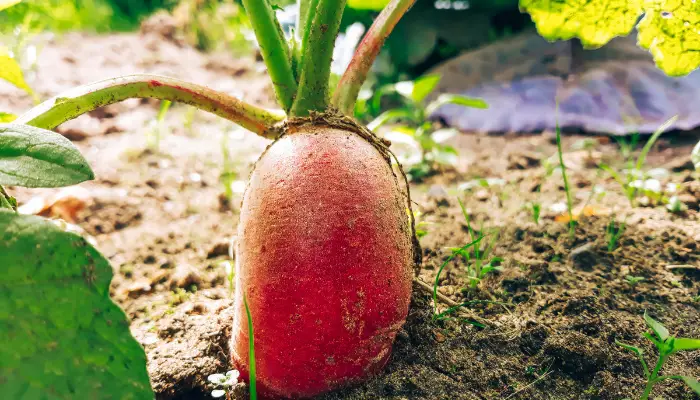
Once the radish seeds have germinated, you will see tiny green sprouts emerging from the soil. These are radish seedlings, and they need some care and attention to grow into healthy and tasty radishes. Here are some tips on how to care for radish seedlings:
Thin the seedlings
When the radish seedlings are about 2 inches tall, you should thin them out to give them more space and reduce competition. You can use scissors or your fingers to snip or pull out the excess seedlings, leaving one radish plant every 2 to 3 inches. You can eat the thinned seedlings as microgreens, or add them to salads or sandwiches.
Water the seedlings
You should water the radish seedlings regularly, but not too much. The soil should be moist, but not soggy. You can check the soil moisture by inserting your finger into the soil. If it feels dry, water the seedlings. If it feels wet, wait until it dries out a bit. You can also use a mulch, such as straw, grass clippings, or leaves, to conserve soil moisture and prevent weeds.
Fertilize the seedlings.
You don’t need to fertilize the radish seedlings too much, as they are fast-growing and don’t need a lot of nutrients. However, you can apply a balanced organic fertilizer, such as compost, worm castings, or fish emulsion, once or twice during the growing season to boost the growth and flavor of the radishes.
Weed the seedlings
You should weed the radish seedlings regularly to prevent weeds from competing with them for water, nutrients, and space. You can use a hoe, a cultivator, or your hands to remove the weeds, being careful not to damage the radish roots. You can also use a mulch to suppress weed growth.
Protect the seedlings
You should protect the radish seedlings from pests and diseases, such as flea beetles, cabbage worms, root maggots, aphids, slugs, snails, and powdery mildew. You can use organic methods, such as row covers, insecticidal soap, neem oil, diatomaceous earth, or garlic spray, to deter or control the pests and diseases. You can also use companion plants, such as marigolds, nasturtiums, or garlic, to repel or attract the pests away from the radishes.
How to Harvest Radishes
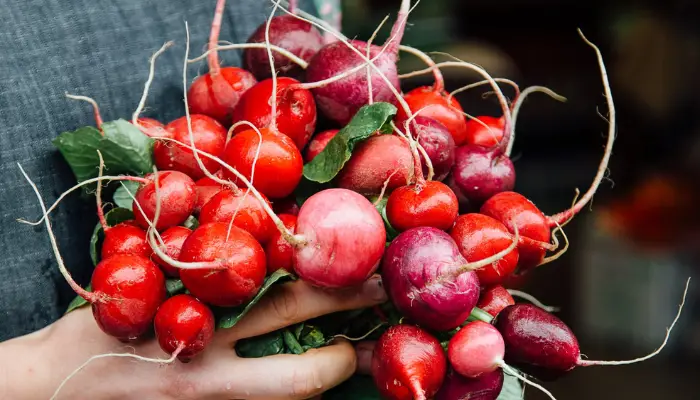
Radishes are ready to harvest when they reach their desired size and shape, which depends on the variety and growing conditions. Generally, radishes are ready to harvest in 4 to 6 weeks after planting, but some varieties may take longer or shorter. You can check the radish size by gently brushing away the soil around the base of the plant and looking at the top of the root. The radish should be firm, smooth, and colorful, and not too big or too small. If the radish is too big, it may become woody, pithy, or bitter. If the radish is too small, it may not have developed enough flavor or crunch.
To harvest radishes, you can use a garden fork, a trowel, or your hands to loosen the soil around the radish and pull it out gently. You can also cut the radish tops with scissors or a knife and leave the roots in the ground until you are ready to eat them. However, you should not leave the radishes in the ground for too long, as they may become tough, split, or bolt (produce flowers and seeds).
You should harvest radishes in the morning or evening, when the temperature is cooler and the radishes are more crisp and juicy. You should also wash the radishes well and remove any dirt, insects, or damaged parts. You
Some Common Pests and Diseases of Radishes?
Some common pests and diseases of radishes are:
Aphids
These are small, sap-sucking insects that can damage the leaves and stems of radishes. They can also transmit viruses and other pathogens. You can control them by spraying them with insecticidal soap, neem oil, or a homemade solution of water, dish soap, and garlic. You can also attract beneficial insects, such as ladybugs, lacewings, and hoverflies, that feed on aphids.
Cabbage loopers
These are green caterpillars that chew holes in the leaves of radishes and other brassicas. They can reduce the yield and quality of the crop. You can control them by covering the plants with row covers, hand-picking them, or applying Bacillus thuringiensis (Bt), a natural bacterium that kills caterpillars.
Cabbage maggots
These are white, legless larvae that bore into the roots of radishes and other crucifers. They can cause wilting, stunting, and rotting of the roots. They can also spread bacterial and fungal diseases. You can control them by rotating crops, applying diatomaceous earth, or using nematodes, which are microscopic worms that parasitize the maggots.
Cutworms
These are brown or gray worms that cut off the stems of young radish plants at the soil level. They can kill the plants or reduce their growth. You can control them by tilling the soil before planting, placing collars around the stems, or sprinkling coffee grounds or eggshells around the plants.
Powdery mildew
This is a fungal disease that causes white, powdery patches on the leaves and stems of radishes. It can reduce the photosynthesis and vigor of the plants. You can control it by avoiding overhead watering, improving air circulation, or spraying the plants with a fungicide or a homemade solution of water, baking soda, and vegetable oil.
These are some of the most common pests and diseases of radishes, but there are others that may affect your crop. You can find more information on how to identify and control them in the web search results.
FAQ on Radish Pests and Diseases
Q: What are some common pests that attack radishes?
A: Some common pests that attack radishes include aphids, cutworms, cabbage loopers, cabbage maggots, slugs, snails, beetles, and thrips. These pests can damage the leaves, stems, and roots of radishes and reduce the yield and quality of the crop. They can also transmit diseases and pathogens to the plants.
Q: How can I control radish pests organically?
A: You can control radish pests organically by using various methods, such as:
- Covering the plants with row covers or netting to exclude pests.
- Hand-picking or trapping the pests and disposing of them.
- Spraying the plants with water, soap, oil, or vinegar to dislodge or deter pests.
- Applying natural pesticides, such as neem oil, garlic spray, or insecticidal soap, to kill or repel pests.
- Attracting beneficial insects, such as ladybugs, lacewings, or hoverflies, that feed on pests.
-
Plant companion plants, such as marigolds, nasturtiums, or garlic, that repel or distract pests.
Q: What are some common diseases that affect radishes?
Some common diseases that affect radishes include rust, mold, blight, clubroot, fusarium wilt, downy mildew, powdery mildew, black root, scab, and damping-off. These diseases are caused by fungi, bacteria, or viruses and can affect the leaves, stems, and roots of radishes. They can cause wilting, yellowing, browning, spotting, rotting, or stunting of the plants.
Q: How can I prevent or treat radish diseases organically?
A: You can prevent or treat radish diseases organically by using various methods, such as:
- Rotating crops and avoiding planting radishes in the same spot for more than two years.
- Choosing disease-resistant varieties and healthy seeds.
- Improving soil drainage and aeration, and adding organic matter and compost.
- Watering the plants at the base and avoiding overhead watering or splashing.
- Pruning or removing infected or damaged plant parts and disposing of them.
- Applying natural fungicides, such as baking soda, copper, or sulfur, to prevent or cure fungal diseases.
- Applying natural bactericides, such as hydrogen peroxide or vinegar, to prevent or cure bacterial diseases.
Q: How can I tell if my radishes are ready to harvest?
A: You can tell if your radishes are ready to harvest by checking the size and shape of the roots. Generally, radishes are ready to harvest in 4 to 6 weeks after planting, but some varieties may take longer or shorter. You can gently brush away the soil around the base of the plant and look at the top of the root. The radish should be firm, smooth, and colorful, and not too big or too small. If the radish is too big, it may become woody, pithy, or bitter. If the radish is too small, it may not have developed enough flavor or crunch.

